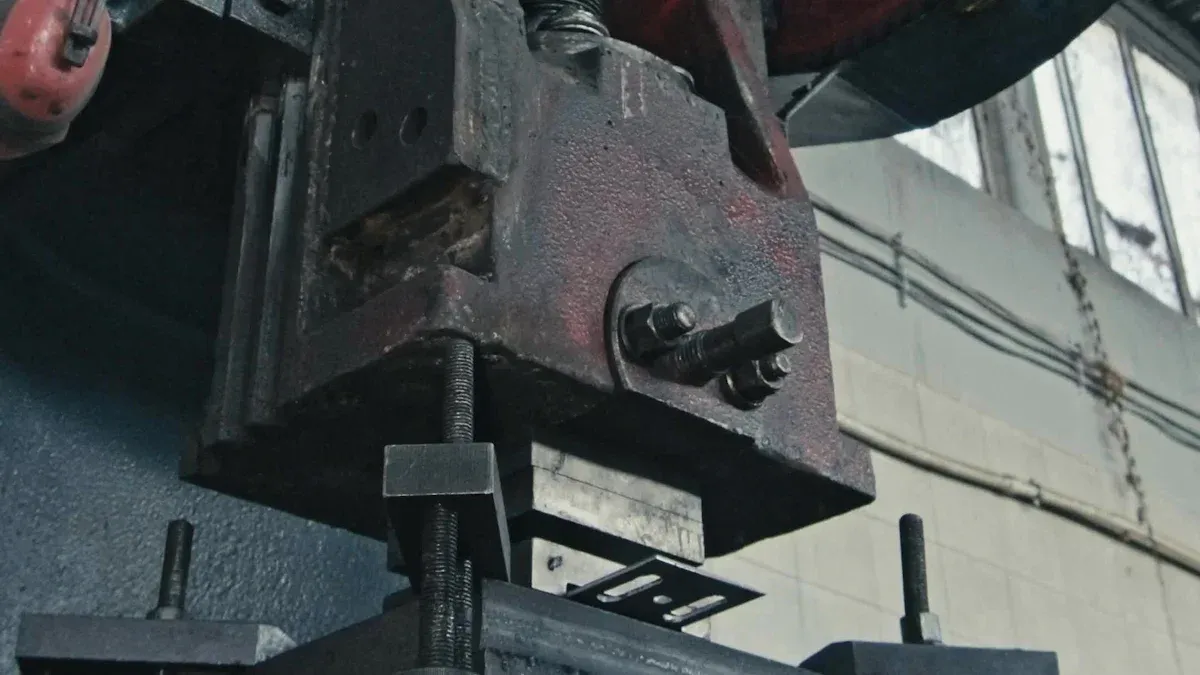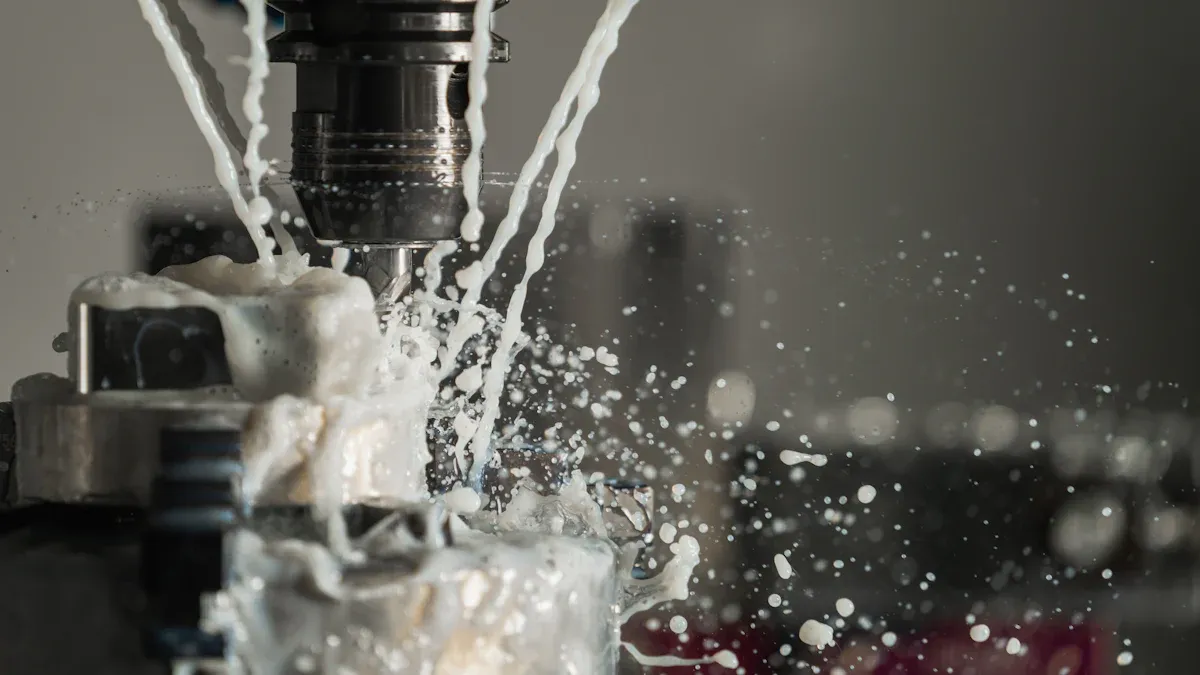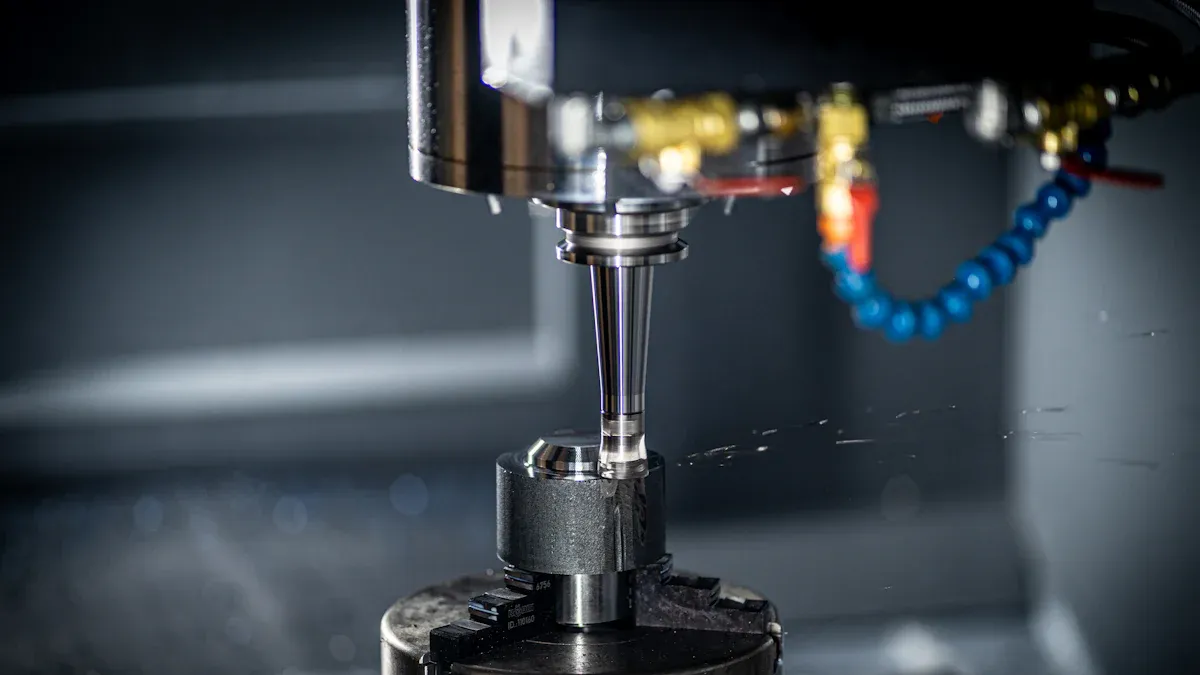
TAC coating revolutionizes machining by creating a protective layer on tools. You experience improved performance as this coating minimizes tool wear and boosts efficiency. It enhances durability, ensuring tools last longer under intense conditions. Additionally, you gain precision and cost savings, as TAC coating reduces the need for frequent replacements and post-machining processes.
Key Takeaways
- TAC Coating makes tools last longer by adding a shield. This reduces damage and means tools need fewer replacements.
- TAC Coating helps machines work better by cutting friction and heat. This allows faster cutting and more accurate results.
- TAC Coating improves surface smoothness, so less polishing is needed. This saves time and cuts down on production costs.
Enhanced Tool Durability with TAC Coating
Prolonging the lifespan of cutting tools
You rely on cutting tools to perform consistently, even under demanding conditions. TAC Coating plays a crucial role in extending their lifespan. This advanced coating forms a protective barrier on the tool’s surface, shielding it from damage caused by friction and heat. As a result, your tools maintain their sharpness for longer periods, reducing the need for frequent replacements.
Imagine working with a tool that stays effective after multiple uses. TAC Coating makes this possible by minimizing the impact of wear and tear. This not only saves you money but also ensures uninterrupted operations. With tools that last longer, you can focus on achieving precision without worrying about performance degradation.
Reducing wear and tear in high-stress environments
Machining processes often involve high-stress environments where tools face extreme pressure and heat. Without proper protection, tools can degrade quickly. TAC Coating addresses this challenge by enhancing the tool’s resistance to these harsh conditions. It reduces surface friction, which lowers the heat generated during machining.
By using TAC Coating, you prevent premature tool failure. This coating also helps maintain the structural integrity of your tools, even when machining tough materials. Whether you’re working with metals or composites, TAC Coating ensures your tools perform reliably, even in the most demanding scenarios.
Tip: Regularly inspect your tools to monitor the effectiveness of the coating and ensure optimal performance.
Improved Surface Finishing Using TAC Coating

Achieving smoother finishes on machined parts
You know how important surface quality is for machined parts. TAC Coating helps you achieve smoother finishes by reducing friction between the tool and the material. This coating minimizes microscopic scratches and imperfections during machining. As a result, the finished parts have a polished appearance straight off the machine.
When you use TAC Coating, the tool glides more easily over the material. This reduces the chances of uneven cuts or rough edges. Whether you’re working with metals, plastics, or composites, TAC Coating ensures consistent results. Smooth surfaces not only improve the aesthetic appeal but also enhance the functionality of the parts, especially in industries like aerospace and medical devices.
Note: Smoother finishes reduce the risk of defects, saving you time and resources during quality checks.
Reducing post-machining polishing requirements
Polishing can be time-consuming and costly. TAC Coating reduces the need for extensive post-machining polishing. By delivering high-quality finishes during the machining process, it eliminates additional steps in your workflow. This saves you both time and effort.
You can rely on TAC Coating to produce parts that meet surface finish standards without extra polishing. This is especially beneficial in mass production, where efficiency matters most. With fewer polishing requirements, you lower production costs and increase overall productivity.
Tip: Evaluate your machining process to identify areas where TAC Coating can reduce finishing work.
Increased Cutting Efficiency Through TAC Coating
Enhancing cutting speed and precision
You know how critical speed and precision are in machining processes. TAC Coating enhances both by reducing friction between the tool and the material. This allows the tool to move more smoothly and quickly, cutting through materials with minimal resistance. As a result, you achieve faster machining cycles without compromising accuracy.
When you use TAC Coating, the tool maintains its sharpness for longer periods. This consistency ensures precise cuts, even during extended operations. You can rely on this coating to deliver high-quality results, whether you’re working on intricate designs or large-scale production.
Tip: Monitor your machining parameters to fully leverage the speed and precision benefits of TAC Coating.
Minimizing material deformation during machining
Material deformation can compromise the quality of your machined parts. TAC Coating minimizes this issue by reducing the heat generated during cutting. Lower heat levels prevent the material from softening or warping, ensuring that the final product retains its intended shape and dimensions.
This coating also reduces the force exerted on the material during machining. With less stress applied, you avoid unwanted distortions and achieve cleaner cuts. Whether you’re working with metals, plastics, or composites, TAC Coating helps you maintain the structural integrity of your materials.
Note: Consistent tool performance with TAC Coating reduces the risk of defects caused by material deformation.
Reduced Friction in Machining with TAC Coating
Lowering heat generation during operations
Friction during machining generates heat, which can damage tools and materials. You can reduce this heat by using TAC Coating. This coating creates a smooth surface on your tools, minimizing contact with the material. Less contact means less friction, which keeps the temperature lower during operations.
When heat levels drop, your tools last longer, and the material remains intact. This is especially important when working with heat-sensitive materials like plastics or thin metals. By maintaining a cooler environment, you avoid issues like tool deformation or material warping.
Tip: Monitor the temperature during machining to ensure the coating is performing effectively.
Preventing material adhesion to tools
Material sticking to tools is a common problem in machining. It can cause uneven cuts, reduce precision, and damage the tool. TAC Coating prevents this by creating a non-stick surface. The coating reduces the chances of material particles adhering to the tool, ensuring smoother operations.
With TAC Coating, you achieve cleaner cuts and avoid interruptions caused by material buildup. This is particularly useful when machining soft or sticky materials like aluminum or certain composites. You save time by reducing the need for frequent tool cleaning, which also improves overall productivity.
Note: Regularly inspect your tools to ensure the coating remains effective in preventing adhesion.
Aerospace Applications of TAC Coating

Machining lightweight, high-strength materials
In aerospace manufacturing, you often work with lightweight yet high-strength materials like titanium and aluminum alloys. These materials are essential for reducing aircraft weight while maintaining structural integrity. However, machining them can be challenging due to their toughness and tendency to generate heat during cutting. This is where TAC Coating becomes invaluable.
TAC Coating enhances your tools‘ ability to handle these materials effectively. By reducing friction, it minimizes heat buildup, which prevents material deformation and tool wear. You can achieve precise cuts without compromising the material’s properties. This coating also ensures that your tools maintain their sharpness, even when machining tough alloys.
Tip: Use TAC Coating to improve efficiency when working with heat-sensitive aerospace materials.
Ensuring precision in critical aerospace components
Precision is non-negotiable in aerospace manufacturing. Components like turbine blades and engine parts must meet exact specifications to ensure safety and performance. TAC Coating helps you achieve this level of precision by enhancing tool stability and reducing vibrations during machining.
With TAC Coating, your tools deliver consistent performance, allowing you to produce parts with tight tolerances. The coating also prevents material adhesion, ensuring clean and accurate cuts. Whether you’re crafting intricate designs or large components, TAC Coating ensures that every part meets the highest quality standards.
Note: Precision machining with TAC Coating reduces the risk of defects, saving time and resources during inspections.
Medical Device Production and TAC Coating
Machining biocompatible materials with precision
You know how critical precision is when machining biocompatible materials for medical devices. These materials, such as titanium and stainless steel, require careful handling to maintain their properties. TAC Coating enhances your ability to machine these materials with exceptional accuracy. By reducing friction, it allows tools to cut smoothly, minimizing the risk of defects.
When you use TAC Coating, your tools stay sharp longer, ensuring consistent performance. This is especially important when creating intricate components like surgical instruments or implants. The coating also reduces heat generation, which helps preserve the material’s biocompatibility. With TAC Coating, you can achieve the exact specifications needed for medical-grade parts.
Tip: Always monitor tool performance to ensure the coating continues to deliver precise results.
Ensuring contamination-free surfaces for medical use
Medical devices must meet strict hygiene standards. Contaminants on their surfaces can lead to serious health risks. TAC Le revêtement vous aide à maintenir contamination-free surfaces during machining. Its non-stick properties prevent material buildup on tools, reducing the chances of transferring debris to the finished parts.
You can rely on TAC Coating to produce clean, smooth surfaces that require minimal post-machining cleaning. This saves time and ensures compliance with medical regulations. Whether you’re manufacturing implants or diagnostic equipment, TAC Coating supports you in delivering safe, high-quality products.
Note: Regularly inspect tools for wear to maintain the coating’s effectiveness in preventing contamination.
Automotive Industry Benefits from TAC Coating
Enhancing the machining of engine components
You know how critical precision is when machining engine components. These parts must meet exact specifications to ensure optimal performance and safety. TAC Coating helps you achieve this by improving tool efficiency and reducing friction during machining. With this coating, your tools cut through tough materials like steel and aluminum alloys more smoothly. This reduces wear and ensures consistent results.
TAC Coating also minimizes heat generation, which is essential when working with heat-sensitive engine components. Lower temperatures prevent material deformation, allowing you to maintain the integrity of the parts. Whether you’re machining pistons, crankshafts, or cylinder heads, TAC Coating ensures that every component meets the highest quality standards.
Tip: Use TAC Coating to improve machining efficiency and reduce tool wear when working with complex engine designs.
Improving the durability of high-performance parts
High-performance automotive parts, such as turbochargers and transmission components, face extreme conditions. These parts must withstand high temperatures, pressure, and friction. TAC Coating enhances the durability of these parts by ensuring precise machining and reducing surface imperfections.
When you use TAC Coating, your tools produce smoother finishes, which improves the performance and lifespan of the parts. The coating also prevents material adhesion, ensuring clean cuts and reducing the risk of defects. This is especially important in high-performance vehicles, where even minor imperfections can impact efficiency.
Note: TAC Coating helps you meet the demands of high-performance machining while maintaining cost-effectiveness.
Cost-Effectiveness of TAC Coating in Mass Production
Reducing tool replacement costs
You know how frequent tool replacements can disrupt production and increase costs. TAC Coating helps you reduce these expenses by extending the lifespan of your tools. The coating protects tools from wear and tear, allowing them to perform consistently over longer periods. This means fewer replacements and less downtime for your operations.
Imagine the savings you achieve when your tools last twice as long. TAC Coating makes this possible by minimizing damage caused by friction and heat. You spend less on purchasing new tools and more time focusing on production. This cost-saving benefit is especially valuable in industries where tools face high-stress conditions, such as automotive and aerospace manufacturing.
Tip: Track tool performance to measure how TAC Coating reduces replacement frequency.
Lowering overall production expenses
Production costs often rise due to inefficiencies like tool wear, material waste, and extended machining times. TAC Coating addresses these challenges by improving tool efficiency and reducing friction during machining. With smoother operations, you use less energy and produce fewer defective parts.
You also save money by reducing post-machining processes like polishing or cleaning. TAC Coating delivers high-quality finishes directly from the machine, eliminating extra steps. In mass production, these savings add up quickly, helping you lower overall expenses while maintaining high output levels.
Note: Evaluate your workflow to identify areas where TAC Coating can streamline operations and reduce costs.
Scalability of TAC Coating Across Industries
Adapting TAC coating for small-scale and large-scale operations
Vous pouvez postuler TAC Coating effectively, whether you run a small workshop or a large manufacturing plant. Its adaptability makes it suitable for operations of any size. In small-scale setups, you benefit from its ability to extend tool life and reduce costs. This allows you to focus on delivering high-quality products without worrying about frequent tool replacements.
For large-scale operations, TAC Coating supports high-volume production by improving efficiency and reducing downtime. Tools coated with TAC Coating perform consistently, even during extended machining cycles. This ensures that your production lines run smoothly, meeting tight deadlines and maintaining quality standards.
Tip: Evaluate your production scale to determine how TAC Coating can optimize your operations.
Customizing coatings for specific industrial needs
Every industry has unique requirements, and TAC Coating can be tailored to meet them. You can customize the coating to suit specific materials, machining conditions, or performance goals. For example, aerospace manufacturers may need coatings that handle high-strength alloys, while medical device producers require coatings that ensure contamination-free surfaces.
This flexibility allows you to achieve the best results for your specific applications. By working with coating specialists, you can develop solutions that enhance tool performance and meet industry standards. Customization ensures that TAC Coating delivers maximum value, regardless of your field.
Note: Collaborate with experts to design coatings that align with your operational needs.
Environmental Advantages of TAC Coating
Reducing the need for lubricants and coolants
You often rely on lubricants and coolants to reduce friction and heat during machining. However, these substances can be costly and harmful to the environment. TAC Coating offers a sustainable alternative by minimizing the need for these additives. The coating reduces friction between the tool and the material, which lowers heat generation during operations. This allows you to perform machining tasks without excessive reliance on lubricants or coolants.
By using TAC Coating, you simplify your workflow and reduce waste. You no longer need to dispose of large quantities of used lubricants, which often require special handling due to their environmental impact. This not only saves you money but also helps you adopt greener practices in your machining processes.
Tip: Evaluate your current lubricant usage to identify areas where TAC Coating can help you cut back.
Lowering the environmental impact of machining processes
Machining processes often contribute to environmental pollution through waste generation and energy consumption. TAC Coating helps you address these issues by improving tool efficiency and reducing waste. Tools coated with TAC Coating last longer, which means fewer tools end up in landfills. Additionally, the coating enhances cutting performance, allowing you to complete tasks faster and use less energy.
When you adopt TAC Coating, you take a step toward sustainable manufacturing. The reduced need for lubricants, combined with longer tool life, significantly lowers your environmental footprint. This makes TAC Coating an excellent choice for businesses aiming to balance productivity with eco-friendly practices.
Note: Switching to TAC Coating can help you meet environmental regulations while maintaining high machining standards.
TAC Coating has revolutionized machining by enhancing tool durability, efficiency, and cost-effectiveness. You can rely on it to improve precision and reduce waste across industries. Its adaptability ensures it meets diverse needs, from aerospace to medical devices. As technology advances, TAC Coating will continue shaping the future of manufacturing.
FAQ
Qu'est-ce que le TAC Revêtement fait de ?
TAC Coating consists of advanced materials like titanium and carbon. These materials create a durable, heat-resistant layer that enhances tool performance during machining.
Can TAC Coating be applied to all tools?
You can apply TAC Coating to most cutting tools, including drills, end mills, and inserts. However, consult a specialist to ensure compatibility with your tools.
Comment le revêtement TAC améliore-t-il l'efficacité de l'usinage?
TAC Coating reduces friction and heat during machining. This allows tools to cut faster and more precisely, improving overall productivity and reducing material waste.
Tip: Regular maintenance ensures TAC Coating remains effective for longer periods.


